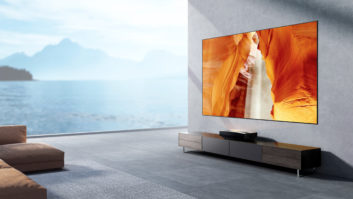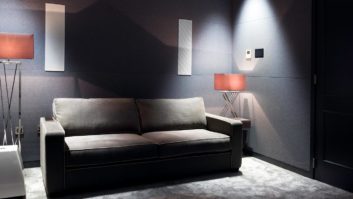Have you ever watched the pros at the Amp Toss during the annual Installer Olympics at CEDIA EXPO? They grab a 78-pound metal box of iron, hoist it to shoulder level and with a great heave, use both arms to “throw” this clunky piece of electronics as far as they can. What if you could throw all the heavy amps out of your life forever? Now you can.
While the rest of the custom integrator’s arsenal has made the jump to digital technology, the analog amplifier remains a relic of yesterday’s know-how. Gone are vinyl LPs, replaced by CDs. Gone are analog tapes, replaced by DVDs. And going away are CRTs, replaced by DLP, LCD and plasma. In the audio arena, amplification is the last analog link in the digital audio chain.
Enter the digital amplifier. At less than one fifth the weight, one eighth the heat and one fourth the size of their analog ancestors, digital amplifiers offer substantial benefits to the custom integrator, especially to the installer who has to assemble and install the racks.
Those benefits come just in time. Both experience and market surveys show that distributed audio is the fastest growing segment of the residential systems market. Many homes now need 12-20 or more channels and buyers expect “digital” quality from all electronics.
Home theater software is moving from five channels, to six and seven channels. If you attended Russ Hershelmann’s or Dr. Floyd Toole’s classes at CEDIA, you heard them–and others–advocate seven channels of audio. At the same time, the market’s appetite for power is growing. Whereas 100 watts per channel sufficed last year, it’s 120 watts this year and quickly growing to 150 or more.
We all know that speakers are getting smaller, but smaller speakers are less efficient. Yes, you can get good performance from a small speaker, but they require more power.
All of this adds to the demand for greater power density, which only digital amplifiers can deliver. While old analog amplifiers burn off up to 50 percent of their power in heat, well designed digital amplifiers are more than 93 percent efficient. When the demand for power increases to 150 watts per channel, analog amps will no longer be able to draw enough power from 120-volt wall socket to meet the demand. So while it’s a struggle of physics to get 1,000 watts from an analog amplifier, the digital amplifier can deliver 1,500 to 2,000 watts or more.
In addition to total power, residential systems customers want fewer and smaller components. A slim, silver, quality 100-watt-per-channel DVD receiver is an ideal match for a plasma display and in-wall speakers. This “lifestyle” trend in components will continue to grow and digital amplifiers will play an integral part of this movement.
With any new technology, quality is the result of smart innovation and exceptional engineering. While Class-D amplifiers have been a novelty in most markets for many years, true analog-equivalent performance has been difficult and costly to achieve. Customers are not willing to trade quality for smaller and lighter components. A new generation of digital amplifiers now exists that overcomes the foibles of previous Class-D experiments.
By incorporating DSP technology into the digital amplifier switching circuit, quantum leaps in performance can be realized. Digital amplifiers work on the principle of Pulse Width Modulation (PWM). In this scheme, the analog signal is encoded into a digital pulse, whose varying width correlates to the amplitude of the signal; essentially, a wider pulse yields a louder signal. On paper, this technique works well. In the real world, things are less than ideal. The PWM signal, switching at 500 KHz to 1 MHz, has artifacts that add noise and distortion to the audio signal. These artifacts are caused by FET switching-overshoot in the carrier signal, ringing in the same carrier signal and overall non-linearity of such a fast signal. That’s why less elegant Class-D amplifiers often exhibit unacceptable specs and undesirable sound.
Previous generations of Class-D amplifiers have tried to Band-Aid these inherent design challenges. Some of these patches were successful, but they always add complexity, cost and size to the overall design, often defeating the inherent benefits of Class D. Additionally, designers have always been challenged by the required low-pass filter, which acts as an audio integrator in the Class-D topology.
This filter is inherently susceptible to variations based on the speaker load to which it is connected. While some previous Class-D designs may perform adequately with a nominal 8-ohm load, they can lose significant bandwidth when driving a nominal 4-ohm load. Or they may shut down altogether when driving low loads that are typically found when paralleling together two speakers on an output channel.
The new generation of digital amplifiers has a DSP to correct for these artifacts and load dependencies. This DSP can analyze the internal PWM switching signal of the amplifier, making corrections that greatly lower both the noise floor and total harmonic distortion. While older Class-D designs struggled to get 85dB SNR this new generation of digital amplifier can achieve 110dB SNR or better. Likewise, older and simpler Class-D amplifiers often were rated at one percent or even 10 percent distortion, 0.01 percent THD+N is now possible with well-designed digital amplifiers.
To accommodate for a wide variety of speakers, these new intelligent digital amplifiers offer “speaker compensation.”
All speakers have varying resistances based on frequency. An eight-ohm speaker may range from 3.2 Ohms up to 16 Ohms or more at various frequencies. Resistance is typically high at the crossover frequency. Speaker compensation is a technique whereby the amplifier can actually read this resistance “fingerprint” and EQ accordingly. Additionally, bass management can be easily and correctly set up based on the attached speaker’s low-frequency capability.
Not only can these digital amplifiers now respond to various loads, but they can also accommodate the wide variety of digital music formats and sample rate directly. Whether 44.1KHz, 48KHz, 96KHz or even 192KHz sample rates are provided, the new digital amplifier can synchronize appropriately without the need to decimate or downgrade the signal. This solves a major problem that has concerned audiophiles.
Perhaps the most compelling aspect of DSP is the ability for the amplifier to exhibit intelligence based on the environment. As we look into 2004 we know that receiver manufacturers will be offering “intelligent digital amplifiers” including new features not possible with old analog amplifier technology. One such feature is room equalization. This feature is already being tested in the analog domain in a few high-end A/V receivers using complex and discreet DSPs. However, the most logical and most effective place for EQ to take place is within the amplifier itself. With a 56-bit DSP, extremely precise frequency response analysis can be achieved and very accurate and effective EQ compensations can be made.
Designed especially for the professional installer, these amplifiers will offer PC-based user interfaces that allow the professional to directly manipulate the equalization of the amplifier in both frequency and amplitude to two-decimal place precision. Further, some applications will even allow for adjustment of crossover frequency, delay, gain and individual channel volume.
Go ahead. Toss your old analog amp. The new intelligent digital amplifier finally has come of age.
-Glen Burchers, E.E., is vice president of marketing for D2Audio Corp. (www.d2audio.com) in Austin, Texas.





